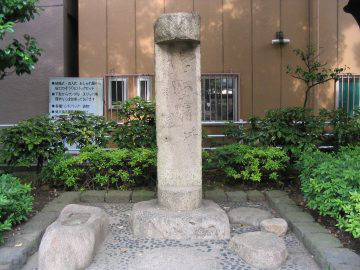
01. Monument of Sukeroku Inscribed with Ichikawa Danjuro's Poem
Hanakawado park, 2 chome 4-15, Hanakawado
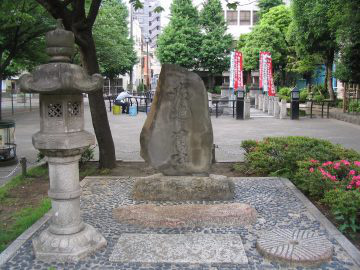
02. Remains of Uba-ga-ike (Ubagaike Pond)
Metropolitan Historic Site
Hanakawado park, 2 chome 4-15, Hanakawado
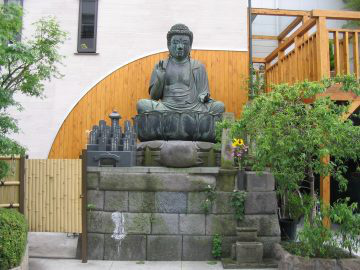
03.Kuhon-ji Buddha
Taito City Tangible Cultural Properties
Kuhon-ji Temple, 2 chome 11-13, Hanakawado
The large statue of Buddha standing on the left-hand side of the temple precincts is a seated image of the Amida Buddha in bronze. It is known as the "Kuhon-ji Daibutsu"(the Great Buddha of Kuhon-ji Temple).
This statue was erected in 1660 as a memorial to those who died in the great fire in Edo in 1657. It was Tenyo, the second chief priest of the temple, who collected votive offerings from the people of Edo to erect the statue. On the pedestal the names of people who contributed are engraved. The artist was Hasegawa Masutsugu, who was active from around 1658 to 1672.
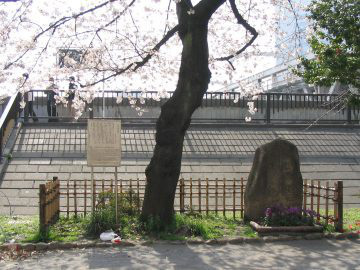
04. Yamanoshuku no Watashi Ferry
Sumida park, 1 chome 1, Hanakawado
In the days when ferries crossed the Sumida River there was a ferry called the "Yamanoshuku no Watashi" (the word "watashi" means ferry). In a map printed in 1907 ferry routes are shown, and "Yamanoshuku no Watashi," which was also known as "Makura-bashi no Watashi" is mentioned. The ferry route was approximately 250 meters upstream of Azuma-bashi Bridge and linked the riverbank at Hanakawado with the Nakanogo Kawaramachi area. The name of the ferry is derived from the name of the district of Yamanoshuku which was to the west of the riverbank at Hanakawado.
The alternative name is connected to the fact that the arrival point on the eastern bank of the river was at the approach to Makura-bashi Bridge. Makura-bashi Bridge stands near to the point where Kitajikken River from Sumida City flows into the Sumida River. It is not clear when the ferry serving this route was started.
From about the mid Edo Period (around the 1690s), the bank of the Sumida River upstream Of Makura-bashi Bridge was popular as a site for cherry blossom viewing.
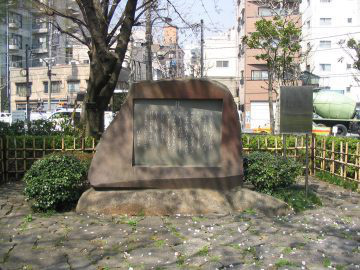
05. Monument of "Hana" Inscribed with Taki Rentaro's Music
Sumida park, 7 chome 1, Asakusa
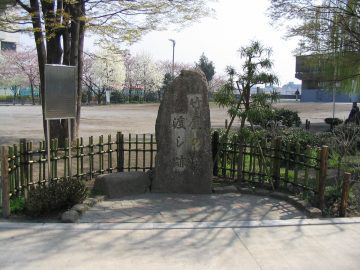
06. The Ferry of Takeya
Sumida park, 7 chome 1, Asakusa
The Ferry of Takeya, also called the Ferry of Matsuchi, was one of the many ferries operating on the Sumida River. It connected Sanyabori and Mukojima Mimeguri Shrine. The name Takeya is said to have been derived from the name of an inn in Sanyabori. The name "Matsuchi" came from the location of the ferry, which was below Matsuchi-yama Shoden. It is unknown when the ferry service actually began, but the business continued until the Kototoi-bashi Bridge was constructed in the early Showa Period.
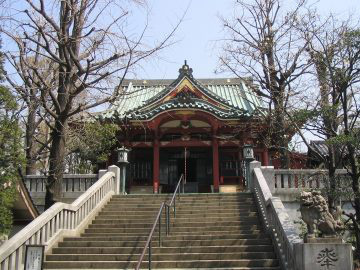
07. Matsuchiyama Shoden
Honryu-in Temple, 7 chome 4-1, Asakusa
Matsuchiyama Shoden is one of the subordinate temples of Kinryuzan Senso-ji Temple. Its proper name is Matsuchiyama Honryuin.
Located alongside the Sumida River and near the Takeya Ferry. It was called a noted place featuring a good view in the Edo Period. Here there are many Nishikie prints of the Edo Period and poems by famous men of letters and painters like Toda Mosui dealing with the scenery of this place. Its main building was destroyed in the Great Kanto Earthquake of 1923 and the World War Ⅱ, but it was rebuilt in 1961.
Radishes seen in its compounds are known as the symbol of health and family harmony while purses represent commercial success.
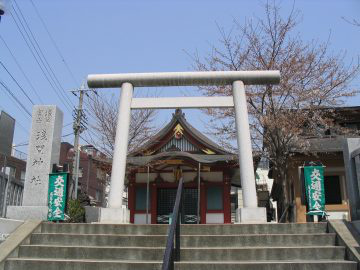
08. Sengen Shrine
Taito City Tangible Cultural Properties
5 chome 3-2, Asakusa
Sengen Shrine is a shrine based on the faith for Mt. Fuji and built in numerous places in the Kanto and Tokai Regions. This particular Sengen Shrine was built by the year 1671 and worships the god Konohanasakuya-hime (goddess). From the 18th to the 19th centuries, a Mt. Fuji faith group (Fuji-ko) was organized in all parts of Edo. However, many Fuji-ko followers gathered at this shrine, and it became famous as the Sengen Shrine representing Edo.
During the Plant Festival held on the last Saturdays of May and June, and during the "Mt. Fuji Opening" on July 1, even now many followers go on pilgrimages to this shrine.
The current main shrine building was reconstructed in 1998, but the inner shrine, which was constructed in 1878 in a storage house, style was left intact. Also, in the shrine are many items, including such things as figures of gods, articles of worship, and antique documents. At any rate, the Mt. Fuji faith after the 18th century has been recognized as being very valuable and was designated a Taito City Folklore Cultural Asset in 1999.
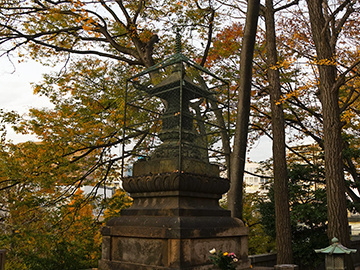
09. Bronze Hokyoin-to
Taito City Tangible Cultural Properties
Honryu-in Temple, 7 chome 4-1, Asakusa
Hokyoin-to refer to Buddhist pagodas constructed based on a sutra called Hokyoindarani-kyo. This particular pagoda has a roof style cover, popular after the latter half of the 18th century, making it very representative of the age it was built in. According to the inscription carved into the foundation, it was built by the caster Nishimura Izuminokami in 1781, and was a donation by 16 fudasashi (rice brokers/usurers) in Kuramae. The Nishimura Izumino-kami was a family of casters that lasted for 11 generations. This pagoda is thought to have been built by Nishimura V, Nishimura Masahira.
Hokyoin-to made of bronze are a rarity in Japan. This pagoda is the only one in Taito City that has been preserved almost in its original condition. It is marked by fine decorations on its various parts and is an excellent example of the high level of skill of the caster.

















